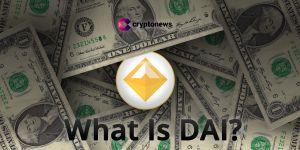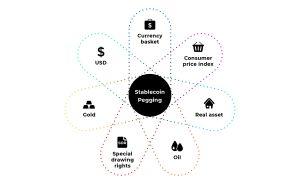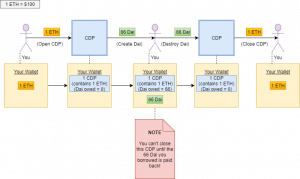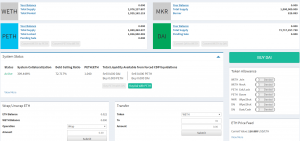Dai is a decentralized cryptocurrency stabilized against the value of the US dollar. Created via the Makers (MKR) Dai Stablecoin System, it uses margin trading to respond to changing market conditions and preserve its value against the major world currencies. Unlike other popular stablecoins whose value is backed directly by USD, it’s backed by crypto collaterals that can be viewed publicly on the Ethereum blockchain.

What Is DAI?
In short, Dai is a decentralized stablecoin created by MakerDAO (MKR). One Dai equals one US dollar (1:1 ratio) and will always remain so until the token is taken out of the circulation.
Dai maintains stable value without centralized trust in a clever and interesting way. It shifts following market changes and thus keeps a steady price against other cryptocurrencies. The process is facilitated by the Maker platform along with the MKR token, CDP smart contracts, and several other stabilization mechanisms. There is no need for a centralized authority that oversees fiat-collateralized stablecoins like Tether (USDT), nor any traditional bank backs it. The project lives entirely on the Ethereum blockchain and its smart contracts, and that makes Dai a truly trustless and decentralized stablecoin which cannot be shut down nor censored.
In summary, the project brings the following benefits:
- One Dai will always be worth $1.
- No government or other centralized authority can shut it down.
- No individual can control it.
- Like other cryptocurrencies, it can be exchanged directly bypassing all middlemen.
- It can be traded freely as any other ERC-20 token.
- It brings trustless stability to the volatile crypto ecosystem.
- Anyone from any place in the globe can receive and send it just by having an Ethereum wallet.
What Is A Stablecoin?

Source: Suicide Ventures
Stablecoin is a cryptocurrency whose value is pegged to less volatile assets like fiat currencies, collaterals, other cryptocurrencies, a basket of goods in a consumer price index, precious metals or oil. Some stablecoin projects even attempt to fix a steady value using algorithms. The general idea of a stablecoin is to produce a crypto asset whose value isn’t prone to extreme volatility.
The most popular stablecoins include Tether (USDT), TrueUSD (TUSD), Dai (DAI), Paxos Standard Token (PAX), USD Coin (USDC), Gemini Dollar (GUSD), and others.
Stablecoins play a vital role in the cryptocurrency ecosystem. With them, anyone can:
- Have a stable store of value during volatile market periods.
- Use a stable cryptocurrency for fast and immutable global remittances and payments.
- Send uncensorable transactions to anyone with a wallet and the internet connection.
- Send large amounts of money with lesser fees.
How Do Stablecoins Differ?
There are four categories of stablecoins:
- Fiat-collateralized. The most common type of stablecoins. Almost all of them rely on centralized institutions and can be centralized. Examples: Tether (USDT), TrueUSD (TUSD), USD Coin (USDC).
- Crypto-collateralized. Crypto-collateralized stablecoins don’t depend on traditional finance infrastructure and use crypto assets as collateral. They are less centralized and transparent, but also more complex by design. Examples: Dai (DAI) & Maker (MKR); Havven (HAV) & nUSD, Bitshares (BTS) BitUSD.
- Algorithmic non-collateralized. These are stablecoins which seek to attain stability by using software-based economic models. They are decentralized by nature, but also highly risky and complex, since they need continuous growth to maintain balance. Examples: Basis, Kowala, Carbon, Fragments.
- Hybrid stablecoins. These are stablecoins which rely on a blend of the approaches listed above. Examples: Reserve, Saga, Aurora – Boreal.
Under this categorization, Dai falls into the crypto-collateralized stablecoin category. It uses Maker (MKR) and Ether (ETH) to maintain a stable value.
What Is Maker (MKR)?
Maker (MKR) is a decentralized autonomous organization (DAO) built on the Ethereum blockchain. Also, it’s a cryptocurrency and a governance token. It’s in charge of two tokens – Makercoin (MKR) and Dai (DAI). Both of them are issued on the Ethereum according to the ERC-20 standard.
Maker (MKR) is on a mission to create a line of stable decentralized digital assets that would be tied to various currencies, gold, and other instruments. The organization is one of the first Ethereum-focused companies and has been working on the technology before Ethereum came to be. The team is highly reputable in the crypto space and is backed by Vitalik Buterin.
Maker holders are in charge of Maker system’s risk management, business logic, payment of Dai loans or setting the debt ratio. Every MKR holder can vote on important decisions related to the platform and DAI issuance, including risk parameters, target rates, price feed sensitivity, global settlement decisions, and more. If one wants to take a loan in Dai, the Maker coin is used to pay the “stability fee.†MKR coins can’t be mined and are burned in the settling process. As of January 2019, Dai is the main Maker’s product, but future plans include adding different currency peg (e.g., USD-DAI or EUR-DAI), and collateralization of ERC-20 tokens.
So how does it all come into play?
How Does DAI Maintain Its Value?
Dai uses game theory and carefully balances economic incentives to continuously sustain the value of $1. When single Dai falls below $1, the system incentivizes users to increase the price. When one Dai is worth more than $1, the incentives work the other way around. In any of these occasions, rational actors can make money due to the price swings. The further Dai deviates from the mean, the better incentives there are to fetch the price back to $1.
In addition to that, Dai coins are always over-collateralized. It means that instead of backing coins 1:1 with their underlying assets (Ether in this case), the ratio is always more than 1:1. For example, if Ether is worth $100 and the collateralization ratio is 150%, you can create 66 Dai.

In more technical terms, it all boils down to margin trading using ETH collateralized debt positions (CDP).
How Is Dai Created?
As a crypto-collateralized stablecoin, Dai is collateralized with Ether. Any Ether holder can create Dai using MakerDAO DApp.

First, you have to send your Ether to a collateralized debt position (CDP). In turn, you would receive a portion of Dai. A CDP is a smart contract which runs on the blockchain and governs the issuance and redemption of Dai. After you receive Dai for your ETH, the only way to get your Ether back is to repay the borrowed DAI. A simplified step-by-step Dai issuance process could look something like this:
- A user deposits ETH (let’s say it’s worth $200).
- He or she issues 100 DAI worth $100 with a collateralization ratio 2:1.
- The user withdraws DAI and uses it as he or she pleases.
- When the user wants to switch DAI back to ETH, he or she must repurchase it with the same 100 DAI + interest. As of January 2019, the Dai annual interest rate is 1%.
- The user pays back the DAI plus accrued interest. The interest fees go directly to MKR token holders for maintaining the system.
As you can see, fundamentally Dai is a loan taken against Ethereum. With MakerDAO, ETH users can request for Dai loans against their Ether holdings. The process begins with turning user’s ETH holdings to the ERC-20 token called WETH (Wrapped Ethereum). Upon doing so, WETH joins the pool of Ethereum, which is used as collateral for all issued DAI tokens. The pool is called PETH (Pooled ETH). Next, PETH is locked to create a Collateralized Debt Position (CDP), and users receive Dai tokens which they are free to use.
The CPD debt ratio tends to increase when Dai is created until it reaches a limit and no more Dai can be withdrawn against the CPD.
Of course, this is a simplified explanation of the mechanisms behind DAI. The good news that 99% of DAI users don’t have to go through all the complexities of issuing DAI and just buy it on the exchange.
Where to Buy DAI?
As of January 2019, Dai can be traded in the following exchanges:
HitBTC (paired with BTC, ETH, USDT, TUSD, XRP, EURS, LTC, XMR, NEO, POA, EOS, BCH).
Bitfinex, Ethfinex (paired with USD, BTC, ETH).
Coinhub (paired with BTC, ETH, LTC).
Coinsuper, Kyber Network (paired with ETH).
Exmo (paired with USD, RUB, BTC, ETH, MKR).
Bancor (paired with BNT).
Radar Relay (paired with WETH, MKR, ZRX, OMG, REP).
Gate.io (paired with USDT).
You can also get Dai using instant exchange services like Changelly.
Where to Store DAI?
Both DAI and Makercoin are Ethereum ERC20 tokens and can be stored in ERC-20 compliant wallets like MyEtherWallet, Atomic, Exodus, Jaxx, Mist, Metamask, and others. For an extra layer of security, you can also use hardware wallet by Ledger or Trezor.
Similar Projects
DigixDAO (DGD) – Bringing the Gold Standard in the Distributed Ledger Technology (DLT).
Maker (MKR) – A utility and governance token, and recapitalization resource of the Maker ecosystem.
TrueUSD (TUSD) – A fiat-collateralized centralized stablecoin issued via TrustToken platform.